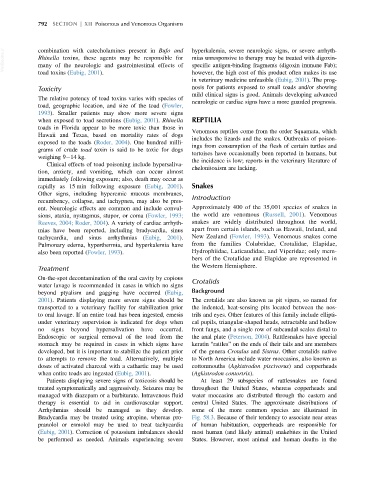Page 834 - Veterinary Toxicology, Basic and Clinical Principles, 3rd Edition
P. 834
792 SECTION | XII Poisonous and Venomous Organisms
VetBooks.ir combination with catecholamines present in Bufo and hyperkalemia, severe neurologic signs, or severe arrhyth-
mias unresponsive to therapy may be treated with digoxin-
Rhinella toxins, these agents may be responsible for
specific antigen-binding fragments (digoxin immune Fab);
many of the neurologic and gastrointestinal effects of
toad toxins (Eubig, 2001). however, the high cost of this product often makes its use
in veterinary medicine unfeasible (Eubig, 2001). The prog-
Toxicity nosis for patients exposed to small toads and/or showing
mild clinical signs is good. Animals developing advanced
The relative potency of toad toxins varies with species of
neurologic or cardiac signs have a more guarded prognosis.
toad, geographic location, and size of the toad (Fowler,
1993). Smaller patients may show more severe signs
when exposed to toad secretions (Eubig, 2001). Rhinella REPTILIA
toads in Florida appear to be more toxic than those in
Venomous reptiles come from the order Squamata, which
Hawaii and Texas, based on mortality rates of dogs
includes the lizards and the snakes. Outbreaks of poison-
exposed to the toads (Roder, 2004). One hundred milli-
ings from consumption of the flesh of certain turtles and
grams of crude toad toxin is said to be toxic for dogs
tortoises have occasionally been reported in humans, but
weighing 9 14 kg.
the incidence is low; reports in the veterinary literature of
Clinical effects of toad poisoning include hypersaliva-
chelonitoxism are lacking.
tion, anxiety, and vomiting, which can occur almost
immediately following exposure; also, death may occur as
rapidly as 15 min following exposure (Eubig, 2001). Snakes
Other signs, including hyperemic mucous membranes, Introduction
recumbency, collapse, and tachypnea, may also be pres-
ent. Neurologic effects are common and include convul- Approximately 400 of the 35,001 species of snakes in
sions, ataxia, nystagmus, stupor, or coma (Fowler, 1993; the world are venomous (Russell, 2001). Venomous
Reeves, 2004; Roder, 2004). A variety of cardiac arrhyth- snakes are widely distributed throughout the world,
mias have been reported, including bradycardia, sinus apart from certain islands, such as Hawaii, Ireland, and
tachycardia, and sinus arrhythmias (Eubig, 2001). New Zealand (Fowler, 1993). Venomous snakes come
Pulmonary edema, hyperthermia, and hyperkalemia have from the families Colubridae, Crotalidae, Elapidae,
also been reported (Fowler, 1993). Hydrophiidae, Laticaudidae, and Viperidae; only mem-
bers of the Crotalidae and Elapidae are represented in
the Western Hemisphere.
Treatment
On-the-spot decontamination of the oral cavity by copious Crotalids
water lavage is recommended in cases in which no signs
beyond ptyalism and gagging have occurred (Eubig, Background
2001). Patients displaying more severe signs should be The crotalids are also known as pit vipers, so named for
transported to a veterinary facility for stabilization prior the indented, heat-sensing pits located between the nos-
to oral lavage. If an entire toad has been ingested, emesis trils and eyes. Other features of this family include ellipti-
under veterinary supervision is indicated for dogs when cal pupils, triangular-shaped heads, retractable and hollow
no signs beyond hypersalivation have occurred. front fangs, and a single row of subcaudal scales distal to
Endoscopic or surgical removal of the toad from the the anal plate (Peterson, 2004). Rattlesnakes have special
stomach may be required in cases in which signs have keratin “rattles” on the ends of their tails and are members
developed, but it is important to stabilize the patient prior of the genera Crotalus and Sistrus. Other crotalids native
to attempts to remove the toad. Alternatively, multiple to North America include water moccasins, also known as
doses of activated charcoal with a cathartic may be used cottonmouths (Agkistrodon piscivorus) and copperheads
when entire toads are ingested (Eubig, 2001). (Agkistrodon contortrix).
Patients displaying severe signs of toxicosis should be At least 29 subspecies of rattlesnakes are found
treated symptomatically and aggressively. Seizures may be throughout the United States, whereas copperheads and
managed with diazepam or a barbiturate. Intravenous fluid water moccasins are distributed through the eastern and
therapy is essential to aid in cardiovascular support. central United States. The approximate distributions of
Arrhythmias should be managed as they develop. some of the more common species are illustrated in
Bradycardia may be treated using atropine, whereas pro- Fig. 58.3. Because of their tendency to associate near areas
pranolol or esmolol may be used to treat tachycardia of human habituation, copperheads are responsible for
(Eubig, 2001). Correction of potassium imbalances should most human (and likely animal) snakebites in the United
be performed as needed. Animals experiencing severe States. However, most animal and human deaths in the

